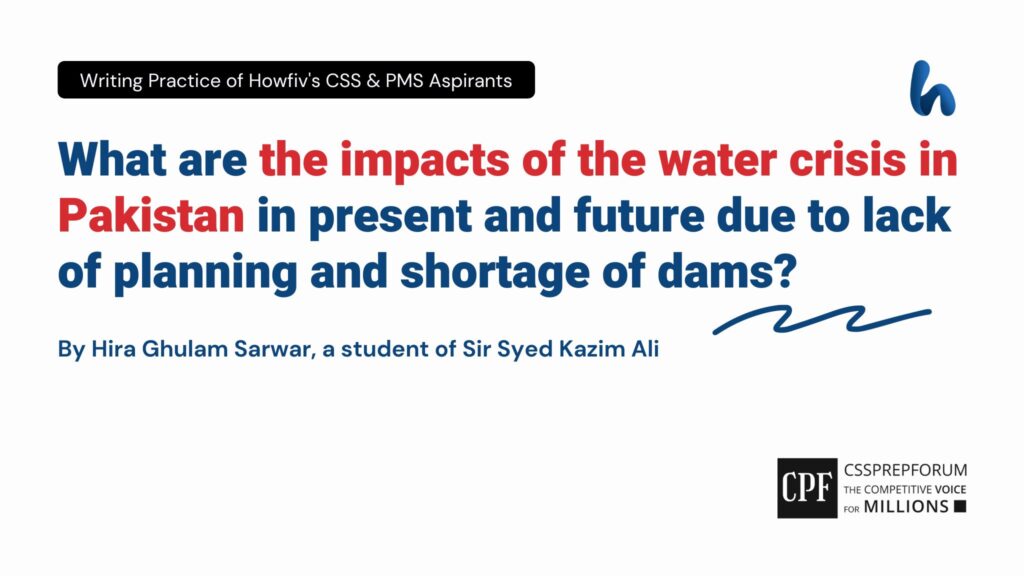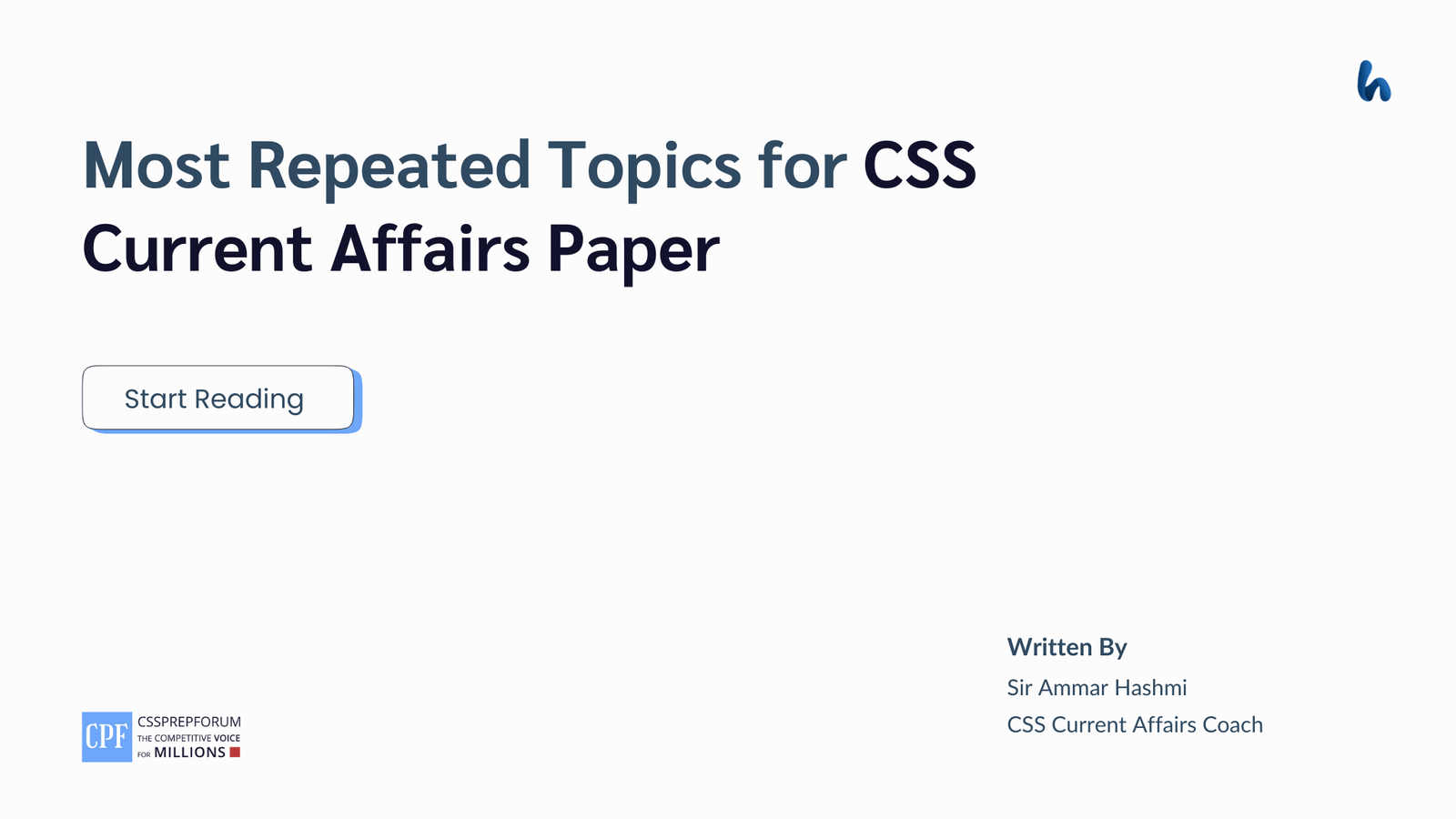The following article is written by Hira Ghulam Sarwar, a student of Sir Syed Kazim Ali. Moreover, the article is written on the same pattern, taught by Sir to his students, scoring the highest marks in compulsory subjects for years. Sir Kazim has uploaded his students’ solved past paper questions so other thousands of aspirants can understand how to crack a topic or question, how to write relevantly, what coherence is, and how to include and connect ideas, opinions, and suggestions to score the maximum.

Outline
1-Introduction
- ✓The sovereignty, political might, and international image of a country stand still on the availability and usage of its natural resources sagaciously for economic growth.
- ✓Lack of planning and shortage of dams in the country has led to the country’s depletion of resources of water and ultimately impacts the burgeoning declivity of socio-economic development and political progress of the country.
2-What is the current portfolio of crisis in the country?
- ✓Pakistan is an agriculture-based economy, and one-third of hydropower generation depends upon water
- ✓More than 80% of the population of the country faces water scarcity for at least one month in the year.
- ✓Water availability is less than 1000 cubic meters per capita in the country and less than 500 cubic meters in Baluchistan.
3-What are the reasons behind this dilemma?
- ✓Climate change
- ✓Excessive water withdrawals
- ✓Minimal storage of water or dams
- ✓Dependence on a single water system
- ✓Trans boundary tussles
- ✓Lack of policy implementation and planning
4-What are the impacts of this crisis in present and future?
- ✓Social impacts
- Existential threats
- Urbanization
- Food insecurity
- ✓Environmental impacts
- Intensification of droughts
- Melting of glaciers
- Deteriorating health sector
- ✓Political impacts
- Inter-provincial tussles
- National disintegration
- Cross-national tensions
- ✓Economic impacts
- The declivity of the agriculture sector
- The decline in the industrial sector
- Less per capita water availability
5-Critical analysis
6-Conclusion

Answer to the Question
Introduction
For preservation and survival, every nation in the universe is highly reliant on the availability of its natural resources, while water secures the uppermost position in all these resources. However, the burgeoning situation of the dearth of water resources in a country can abolish its political and socio-economic fabric and can become a threat to its geological existence. According to the World Bank, the countries that have an availability of water of less than a thousand cubic meters per capita are enlisted in water-scarce countries. Similar is the case with Pakistan, which faced a drastic transition from water abundance at its inception to water scarcity nowadays. According to a report, Pakistan ranks 14 among 17 extremely high-risk countries of the world that also include hot and dry countries like Saudi Arabia. Nonetheless, the factors like excessive annual water withdrawals, climate change, minimal storage of water or dams, Transboundary rustles, and lack of possible implementation have exaggerated the condition of the country desperately. As a result, all these aspects are impacted gravely at the social, political, and economic levels nowadays and might affect in future also if not treated sagaciously. This article will enlighten the root causes and impacts of this crisis in Pakistan in the present and future.
The present water shortage is the greatest future threat to the viability of Pakistan as a state and a society.
Anatol Lieven
The current portfolio of the water crisis in Pakistan
Availability of water at the right time, at the right volume, and at the right price is an essential underpinning of economic growth and development. Unfortunately, Pakistan is suffering from miserable circumstances in the availability of its significant water resources. Pakistan is an agrarian country that is highly dependent upon water reservoirs, but it has the highest water intensity rate in the world, and 78% of its water sources are out of the country. According to the World Resource Institute, Pakistan will be ranked as 23rd number in the top 33 water-stressed countries in 2040. Nonetheless, Worldwide, the country ranks 36th in total renewable water resources compared to India’s rank at 8th and Bangladesh at 12th.
What are the causes behind this calamity in the country?
Since its inception, the country has been facing declivity in its water resources owing to several reasons. For instance, the country is enlisted among the ten most vulnerable countries which are facing huge effects of climate change. Nevertheless, according to Intergovernmental Panel on Climate Change (IPCC), glaciers in the Himalayas are receding faster than in any other part of the world, and if the present rate continues, the likelihood of them disappearing by the year 2035 and perhaps sooner is very high if the Earth keeps warming at the current rate. Similarly, Pakistan ranks 160th in the ratio of water withdrawals to water resources performing better than 18 countries only. Along with all these, the country has had no construction of dams in the last 50 years, while it has the lowest storage capacity only of 30 days in its existing reservoirs. Despite of an agrarian country with and water-intensive economy, the country relies on single water reservoirs; for instance, The Indus River system accounts for 95.8 per cent of the total renewable water resources of the state. Correspondingly the country has also suffered Trans boundary tussles right after its independence. So, all these root causes burgeoning the halting condition and aggregate its water severity.
What are the impacts of this watershed in present and future?
This watershed has catastrophic consequences socially, politically, and above all at the economic level nowadays in the country and if not treated sagaciously and plan wisely, it will affect all aspects of the country in the near future.
- ✓ Social impacts
Because of water shortage, scarcity, and unavailability, day by day, the increasing populace is discerning towards urbanization for the fulfilment of their basic needs. According to a survey, Pakistan has a rapid flow of migration from rural to urban areas as the total urban population was 19.9% in 1955 but 38.9% in 2016 and expectedly will be 45.9% in 2035 and 50.3% in 2050. Similarly, the country is suffering from food insecurity as the country is the second most vulnerable to rising food prices, and an estimated shortage of around 70 million tons of food is expected by 2025. Meanwhile, where there is no food and availability of basic needs for the preservation of life, there are always existential threats to the survival of that state.
- ✓ Environmental impacts
With all sectors, the country has also grieved in the health sector as lack of safe drinking water accessibility to the public leads to poor sanitation and cleaning of water that results in waterborne diseases, like, cholera, diarrhoea, hepatitis, liver abnormalities and ultimately death. Similarly, according to a survey, more than 80% of glaciers, which are the main sources of water for the country, have been melted and will destroy the conditions in future if not wisely treated. Meanwhile, in the near future, due to extreme climate change effects country might face intensification of droughts and super floods occurring once in 5 years which may raise the average flow.
- ✓ Political impacts
Water scarcity in the country has badly affected the political atmosphere and created national disintegration all across the state. Every lower riparian province claims that upper riparian is blocking their water that had decided according to the water accord. So, Sindh alleges Punjab of water theft while Baluchistan accuses Sindh of not giving its share from Guddu and Sukkur Barrages. According to a survey, in 2021, the government of Pakistan’s Sindh province received 5.38 million acre-feet (MAF) of irrigated water, which is a 35 per cent decline in its share in provincial allocation. The emerging water scarcity all over the world can lead to cross-national tensions between countries claiming access to the same rivers, lakes, and basins. According to the world water council, more than 260 river basins are shared by two or more countries, a fact which indicates this catastrophe m become military might to access clean water.
- ✓ Economic impacts
As the country is travail from less water availability per capita and poor water management, it impacts badly upon the economy as the agriculture and industrial sector of the country endured more. Consequently, The Indus Basin aquifer has been ranked as the 2nd most over-stressed underground water reserve in the world. According to a study, water productivity for cereal crops in Pakistan is almost one-third of that in India and one-sixth of the productivity realized in China. So that it influences the economic growth of the state gravely as the absence of a scientific basis, the neglect of water quality issues, the absence of targets, less storage capacity, political will and the provision of financial resources have burgeoned the existing situation and could escalate this in future too.
Critical analysis
The intensification of water scarcity and shortage all across the world has created unrest, and it might have calamitous effects on cross-boundary relations in countries. As per the accounts of the United Nations Environment Programme (UNEP), almost two hundred scientists from fifty countries have declared that there are two most devastating concerns for the new millennium, one of which is water scarcity and the other is global warming. The need of the hour is to change our approach to managing this precious and vital resource. If the wars of this century were fought over oil, the wars of the next century would be fought over water.
Conclusion
Water is the essential and foremost resource for the preservation of life on Earth as it is necessary for food, health, crops, and animal yielding. But with every passing moment, this precious resource is going towards declivity and shortage. In Pakistan, no dams have been constructed after 1975, and the vested interests of politicians do not allow them to give responsiveness to this serious dilemma. Water disputes may harm the existence of the country, and the country can lack politically, socially, and above all, economically.
CSS Solved Past Papers’ Essays
Looking for the last ten years of CSS and PMS Solved Essays and want to know how Sir Kazim’s students write and score the highest marks in the essays’ papers? Then, click on the CSS Solved Essays to start reading them.
CSS Solved Essays

CSS Solved General Science & Ability Past Papers
Want to read the last ten years’ General Science & Ability Solved Past Papers to learn how to attempt them and to score high? Let’s click on the link below to read them all freely. All past papers have been solved by Miss Iqra Ali & Dr Nishat Baloch, Pakistan’s top CSS GSA coach having the highest score of their students.
General Science & Ability Solved Past Papers
CSS Solved Pakistan Affairs Past Papers
Want to read CSS Pakistan Affairs Solved Past Papers and learn how to attempt them to score high? Let’s click on the link below to read them all freely. All past papers’ questions have been attempted by Sir Kazim’s students, who scored the highest in the subject.
CSS Solved Pakistan Affairs
CSS Solved International Relations’ Past Papers
Have you opted for International Relations in the CSS examination and want to score above 150? Then, click on the CSS Solved International Relations’ Past Papers by Miss Abeera Fatima, the top IR scorer and the best IR coach in Pakistan.
CSS Solved International Relations Past Papers
Articles Might Interest You!
The following are some of the most important articles for CSS and PMS aspirants. Click on any to start reading.












